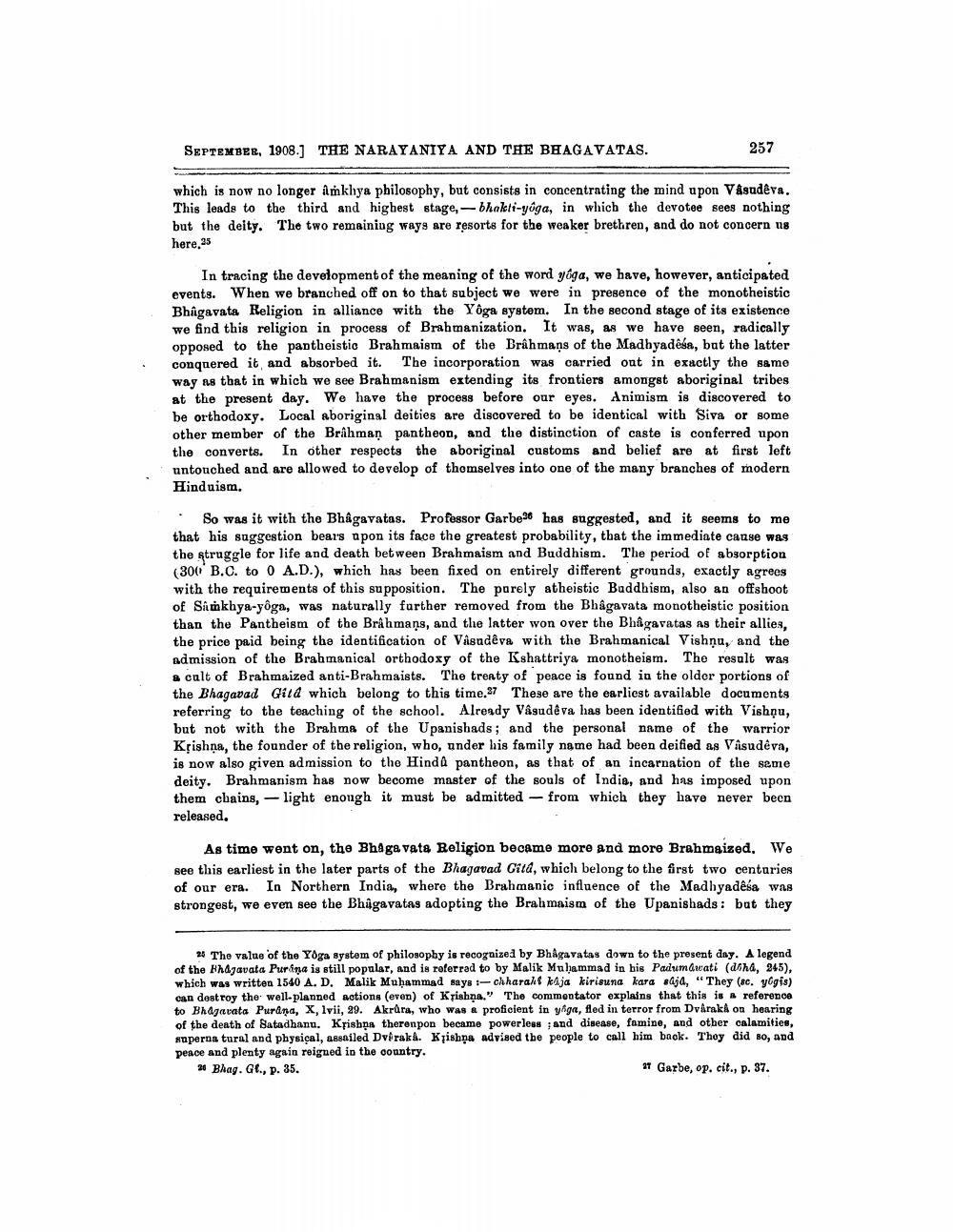________________
SEPTEMBER, 1908.] THE NARAYANIYA AND THE BHAGAVATAS.
257
which is now no longer amkhya philosophy, but consists in concentrating the mind upon Vasudeva. This leads to the third and highest stage, - bhakti-yoga, in which the devotee sees nothing but the deity. The two remaining ways are resorts for the weaker brethren, and do not concern 18 here,25
In tracing the development of the meaning of the word yoga, we have, however, anticipated events. When we branched off on to that subject we were in presence of the monotheistic Bhagavata Religion in alliance with the Yoga system. In the second stage of its existence we find this religion in process of Brahmanization. It was, as we have seen, radically opposed to the pantheistic Brahmaism of the Brâhmans of the Madhyadesa, but the latter conquered it and absorbed it. The incorporation was carried out in exactly the same way as that in which we see Brahmanism extending its frontiers amongst aboriginal tribes at the present day. We have the process before our eyes. Animism is discovered to be orthodoxy. Local aboriginal deities are discovered to be identical with Siva or some other member of the Brahman pantheon, and the distinction of caste is conferred upon the converts. In other respects the aboriginal customs and belief are at first left untouched and are allowed to develop of themselves into one of the many branches of modern Hinduism.
So was it with the Bhagavatas. Professor Garbet has suggested, and it seems to me that his suggestion bear's apon its face the greatest probability, that the immediate cause was the struggle for life and death between Brahmaism and Buddhism. The period of absorption (300 B.C. to 0 A.D.), which has been fixed on entirely different grounds, exactly agrees with the requirements of this supposition. The purely atheistic Buddhism, also an offshoot of Simkhya-yôga, was naturally further removed from the Bhagavata monotheistic position than the Pantheism of the Brahmaņs, and the latter won over the Bhagavatas as their allies, the price paid being the identification of Vasudeva with the Brahmanical Vishnu, and the admission of the Brahmanical orthodoxy of the Kshattriya monotheism. The result was a cult of Brahmaized anti-Brahmaists. The treaty of peace is found in the older portions of the Bhagavad Gita which belong to this time. These are the earliest available documents referring to the teaching of the school. Already Vasudeva has been identified with Vishņu, but not with the Brahms of the Upanishads; and the personal name of the warrior Krishna, the founder of the religion, who, under his family name had been deified as Vasudeva, is now also given admission to the Hindå pantheon, as that of an incarnation of the same deity. Brahmanism has now become master of the souls of India, and has imposed upon them chains, - light enongh it must be admitted — from which they have never been released.
As time went on, the Bhagavata Religion became more and more Brahmaized. We see this earliest in the later parts of the Bhagavad Citd, which belong to the first two centuries of our era. In Northern India, where the Brahmanic influence of the Madhyadeśa was strongest, we even see the Bhügavatas adopting the Brahmaism of the Upanishads: but they
25 The value of the Yoga system of philosophy is recognized by Bhagavatas down to the present day. A legend of the Bhagavata Purana is still popular, and is referrad to by Malik Muhammad in his Padumawati (atha, 945), which was written 1540 A. D. Malik Muhammad says :- chharalt kaja kirisuna kara saja, "They (sc. yogis) can destroy the well-planned actions (even) of KŢishna." The commentator explains that this is reference to Bhagavata Purana, X, lvii, 29. Akrra, who was a proficient in yngre, flod in terror from Dvarakk on hearing of the death of Batadhanu. Krishna theronpon became powerless and disease, famine, and other calamities, supernatural and physical, assailed Dvirak. Kyishna advised the people to call him back. Thoy did so, and peace and plenty again reigned in the country. 20 Bhag. Gl., p. 35.
27 Garbe, op. cit., p. 37.




